Dave Verkh
International American University College of Medicine, International American University, Saint Lucia, West Indies
Epstein-Barr Virus (EBV), or more commonly known as the ‘kissing disease’ is seemingly unavoidable within the adolescent and teenage community. The infection usually begins with symptomology virtually identical to that of the common cold (rhinovirus), or the common flu (influenza virus); this is how it began in the case of one 23-year-old female.
EBV is known to be the most common infectious agent of primary infection, with most resulting in a self-limiting infectious course. In fact, 90% of the general population have been infected with EBV at some point in their life, with only a minority presenting with symptomology.1 The prognosis, however, is not always as desirable as one would hope. The primary infection begins in CD4+ T-lymphocytes, which gives it its atypical cellular morphology. Two types of EBV serotypes exist (Type 1 and 2) which encode particular nuclear proteins in B-lymphocytes that have been latently infected;2 EBV remains latent in those B-lymphocytes subsequent to interacting with the CD21 receptor for the duration of the patient’s life.
The case of one 23-year-old patient was as rare as it was intriguing. The patient presented to the emergency department with tonsillitis and severe scleral icterus (jaundice) with remarkably elevated liver function tests (LFTs): alanine aminotransferase (ALT) 446 U/L and aspartate aminotransferase (AST) 54 U/L. It was also noted that the patient’s alkaline phosphatase (ALP) was 272 U/L with a total bilirubin of 108 μmol/L and a direct bilirubin of 58 μmol/L. While examining the blood-work, atypical lymphocytes were noted, with a contraindicative negative monospot test. The expected lab values for a typical acute EBV infection are said to be 3 to 5-times the normal ALT, with a substantial increase in AST (>2:1 ALT/AST).3 Moreover, a substantial amount of research found jaundice due to hyperbilirubinaemia to be one of the rarest presentations of an acute EBV infection.1 These abnormalities caught the eye of the internist as it was clear that this was not a regular mononucleosis infection but something considerably more aggressive.
A few days after being discharged with a prescription for dexamethasone, the patient was rushed to the emergency room, with LFTs indicating an ALT of 1,255 U/L and an AST of 408 U/L. The ALP and direct bilirubin kept climbing, which was cause for increased concern. ALP is known to increase due to two processes in the body: an injury/obstruction of the biliary system, or the resorption of bone. Once there was clear indication that the biliary system was involved, the gastroenterologist was consulted on the case. After hours of deliberation and consultations, it became clear that the diagnosis was EBV-induced cholestatic hepatitis.
This case supports the idea that EBV-induced cholestatic hepatitis is not as uncommon as previously thought. The pathogenesis of EBV-induced cholestatic hepatitis, although still heavily researched, is thought to be different than that of a typical hepatotropic virus, which infects the hepatocyte directly, causing centrilobular necrosis. One possible explanation of the subsequent cholestasis may be the effect of the virus on the hepatocyte organelles (i.e. mitochondria), which prevent the cell from functioning and interacting with neighbouring biliary cells. Thus, an obstruction is created, which would be evident with an increase in ALP and direct bilirubin as observed in this case. Furthermore, the infection of the hepatocytes would lead to a secondary systemic and intrahepatic production of pro-inflammatory cytokines, which include interleukin (IL)-2, IL-6, and IL-10. The rapid increase of pro-inflammatory cytokines would cause significant swelling which interferes and obstructs the bile movement.4
As previously mentioned, EBV is seemingly unavoidable, and most patients recover with only the basics of care; yet with ongoing research and new evidence being presented, it is becoming evident that the distinction between EBV-induced hepatitis and EBV-induced cholestatic hepatitis is not considered in the differential diagnosis. The ability of today’s technological advances allows healthcare professionals to diagnose viral infections via serology and polymerase chain reaction testing, both of which are specific and sensitive to an indefinite number of viruses. The identification of the virus in a relatively expeditious manner should give healthcare professionals the ability to predict and suspect the potential damage the infection may cause.
EBV-induced cholestatic hepatitis is an extremely important diagnosis to consider in patients that present with an increase in ALP, direct bilirubin, and LFTs of >800 U/L.5 The short-term treatment may not differ; dexamethasone is still widely used for suppression of the inflammation; however, over the long-term, complications could vary. In contrast, it is vital to consider an EBV infection in the differential for patients presenting with cholestasis with an abnormal increase in LFTs. This will drastically expedite the correct diagnosis and treatment plans with reduced unnecessary costly and invasive procedures.5
As the technological advances in healthcare get more complex it is crucial to stop and re-evaluate the patient based on their initial presentation. Simple laboratory testing in addition to a physical exam might be the key to differentiating between EBV-induced hepatitis and EBV-induced cholestatic hepatitis.
References
- Kofteridis DP et al. Epstein Barr virus hepatitis. Eur J Intern Med. 2011;22(1):73-6.
- Sample J et al. Epstein-Barr virus types 1 and 2 differ in their EBNA-3A, EBNA-3B, and EBNA-3C genes. J Virol. 1990;64(9):4084-92.
- Horwitz CA et al. Hepatic function in mononucleosis induced by Epstein-Barr virus and cytomegalovirus. Clin Chem. 1980;26(2):243-6.
- Shaukat A et al. Epstein-Barr virus induced hepatitis: An important cause of cholestasis. Hepatol Res. 2005;33(1):24-6.
- Khoo A. Acute cholestatic hepatitis induced by Epstein-Barr virus infection in an adult: a case report. J Med Case Rep. 2016;10:75.
All information obtained by European Medical Journal and each of the contributions from various sources is as current and accurate as possible. However, due to human or mechanical errors, European Medical Journal and the contributors cannot guarantee the accuracy, adequacy, or completeness of any information, and cannot be held responsible for any errors or omissions. European Medical Journal is completely independent of this blog piece, views and opinions expressed are those of the authors.








